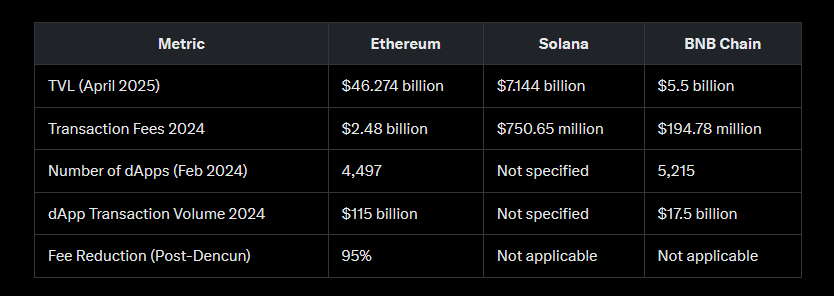Ethereum, the pioneering platform for smart contracts and decentralized applications (dApps), has long been a cornerstone of the blockchain ecosystem. However, as of April 18, 2025, it faces significant fear, uncertainty, and doubt (FUD), driven by competition, internal governance issues, and historical challenges. This note explores the reasons behind the FUD, examines Ethereum’s market position through key metrics, and provides a balanced view of its future prospects, drawing on recent data and analyses.

Reasons for FUD on Ethereum
The FUD surrounding Ethereum stems from several factors. Firstly, competition from newer blockchains like Solana and BNB Chain, often dubbed “Ethereum killers,” has intensified. These competitors offer faster transaction speeds and lower fees, appealing to developers and users. For instance, Solana is known for its high throughput, and BNB Chain has shown surges in daily transaction fees, surpassing Ethereum on certain days in early 2025, as reported in a CoinMarketCap article from February 17, 2025.
Secondly, internal governance issues within the Ethereum Foundation have raised concerns. Recent reports, such as a BeInCrypto article from March 4, 2025, highlight leadership shakeups, controversies like the EigenLayer scandal, and developer dissatisfaction. These issues have led to perceptions of inefficiency and waning market dominance, with some analysts noting Ethereum’s lack of political engagement compared to rivals like Solana and XRP.
Historically, Ethereum faced criticism for high gas fees and scalability issues, particularly before the Dencun upgrade. While these have been partially addressed, the memory of past congestion and high costs lingers, contributing to FUD.
Ethereum’s Market Position: Key Metrics
Despite the FUD, data suggests Ethereum remains a market leader in several critical areas. According to an analysis by Blockchain Lab, Ethereum outperformed competitors in 2024, generating $2.5 billion in blockchain revenue, aligning closely with CoinGecko’s report of $2.48 billion in transaction fees for the year. This positions Ethereum ahead of Tron ($2.15 billion), Bitcoin ($922.89 million), Solana ($750.65 million), and BNB Chain ($194.78 million), as detailed in the same report.
In terms of Total Value Locked (TVL), a key indicator of DeFi adoption, Ethereum currently holds $46.274 billion, significantly higher than Solana’s $7.144 billion and BNB Chain’s $5.5 billion, as per DeFi Llama data. This reflects strong investor confidence in Ethereum’s DeFi ecosystem.
The number of dApps is another metric where Ethereum competes. While Crypto.news reported in February 2024 that BNB Chain had 5,215 dApps compared to Ethereum’s 4,497, the article also noted Ethereum’s dApp transaction volume was $115 billion, over six times BNB Chain’s $17.5 billion. This suggests Ethereum’s dApps are more actively used, despite potentially fewer in number.
Technological advancements further bolster Ethereum’s position. The Dencun upgrade, as highlighted in the Blockchain Lab analysis, reduced blockchain fees by 95% compared to the pre-Dencun era, addressing scalability and cost concerns. Ethereum also benefits from a large validator count, higher than all Layer-2 solutions combined, and sophisticated, well-tested smart contract technology, surpassing competitors like Cardano.
Comparative Analysis with Competitors
To provide context, here’s a table comparing key metrics for Ethereum, Solana, and BNB Chain based on recent data:

Solana stands out for its speed and low fees, with recent reports noting it outperformed Ethereum in daily transaction fees on certain days in late 2024, as per a Coinspeaker article from October 28, 2024. BNB Chain, meanwhile, has shown growth in daily fees, surpassing both in February 2025, driven by meme coin activity, according to the aforementioned CoinMarketCap article.
Addressing Criticisms and Future Outlook
While Ethereum faces FUD, recent upgrades like Dencun have mitigated some criticisms, particularly around high fees. The transition to proof-of-stake with The Merge in 2022 also addressed environmental concerns, though governance issues remain a challenge. The Ethereum Foundation’s ongoing restructuring, as mentioned in a BeInCrypto article from February 4, 2025, aims to tackle these, but their impact is yet to be fully seen.
Ethereum’s first-mover advantage, with a mature ecosystem and extensive developer community, positions it well for the future. However, the blockchain space is dynamic, and competitors are closing the gap. Solana’s rapid growth in daily active users and transactions, as noted in a CoinLedger guide from December 2023, and BNB Chain’s ecosystem expansion suggest a multi-chain future where Ethereum must continue innovating to maintain dominance.
In conclusion, while FUD is prevalent due to competition and internal challenges, Ethereum’s leadership in TVL, transaction fees, and dApp usage underscores its strong market position as of April 2025. However, the evolving landscape means stakeholders should monitor developments closely, particularly around governance and technological advancements.